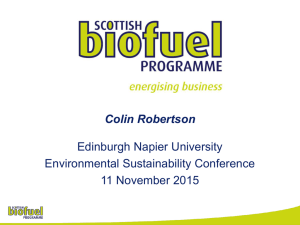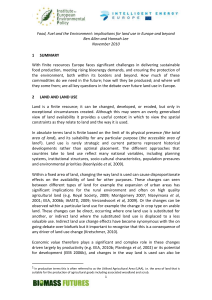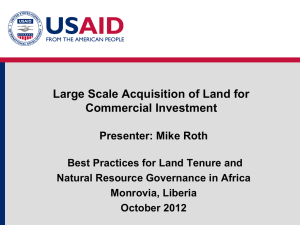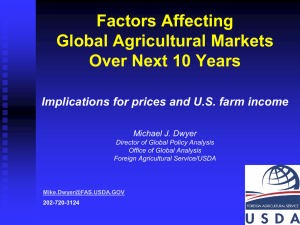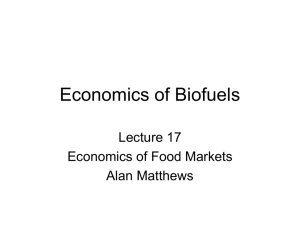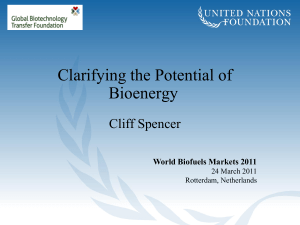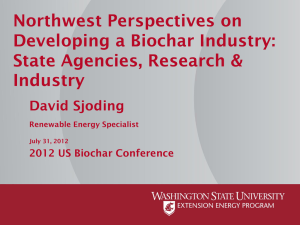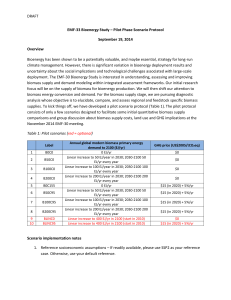Sustainable Production and Distribution of Bioenergy for the Central
advertisement
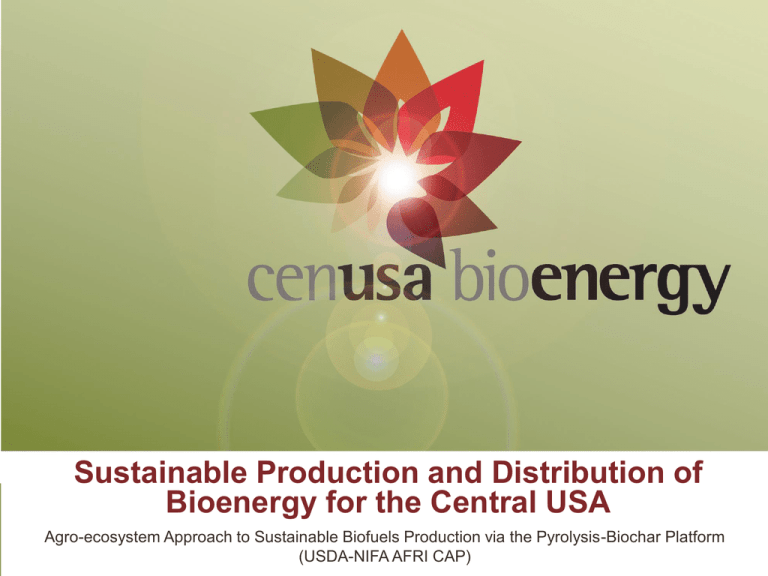
Sustainable Production and Distribution of Bioenergy for the Central USA Agro-ecosystem Approach to Sustainable Biofuels Production via the Pyrolysis-Biochar Platform (USDA-NIFA AFRI CAP) Source: EIA for history, NYMEX for future Jan-20 Jan-18 Jan-16 Jan-14 Jan-12 Jan-10 Jan-08 Jan-06 Jan-04 Jan-02 Jan-00 Jan-98 Jan-96 Jan-94 Jan-92 Jan-90 Jan-88 Jan-86 $ per barrel Oil140Prices 120 100 80 60 40 20 0 Population 2011 2030 2050 (billion) (billion) (billion) World 6.946 World 8.323 World 9.441 China 1.337 India 1.461 India 1.657 India 1.189 China 1.391 China 1.304 U.S. 0.311 U.S. 0.366 U.S. 0.423 Indonesia 0.246 Indonesia 0.289 Nigeria 0.402 Brazil 0.203 Nigeria 0.264 Indonesia 0.313 Pakistan 0.187 Pakistan 0.243 Pakistan 0.291 Nigeria 0.166 Brazil 0.240 Ethiopia 0.278 Bangladesh 0.159 Bangladesh 0.211 Brazil 0.261 Russia 0.139 Ethiopia 0.162 Bangladesh 0.250 Japan 0.127 Philippines 0.138 Philippines 0.172 Source: U.S. Bureau of the Census, International Data Base Liquid Fuel Usage 2007 2015 (Million Barrels Oil Equivalent per Day) 2020 2025 2030 2035 (Percent of 2007 Value) United States 20.6 98% 100% 102% 104% 107% Canada 2.3 96% 96% 96% 100% 104% Mexico 2.1 105% 110% 114% 129% 138% Europe 15.3 92% 88% 88% 89% 90% Japan 5.0 84% 86% 86% 84% 82% China 7.6 132% 153% 178% 201% 222% India 2.8 114% 129% 139% 154% 168% Africa 3.1 113% 116% 126% 135% 148% Central and South America 6.0 110% 112% 117% 125% 133% World 86.1 103% 107% 113% 121% 128% Source: Energy Information Administration Renewable Fuels Standard 40 35 25 20 15 10 5 2022 2021 2020 2019 2018 2017 2016 2015 2014 2013 2012 2011 2010 0 2009 Billion Gallons 30 Conventional Biofuels Cellulosic Biofuels Biodiesel Additional Advanced Biofuels USDA’s Initiative Agriculture and Food Research Initiative - Sustainable Bioenergy This AFRI Challenge Area focuses on the priority to secure America's energy future. It supports the development of regional systems for the sustainable production of bioenergy and biobased products that contribute significantly to reducing dependence on foreign oil, have net positive social, environmental, and rural economic impacts, and are compatible with existing agricultural systems. The long-term outcome for this program is to implement regional systems that materially deliver liquid transportation biofuels to help meet the Energy Independence and Security Act (EISA) of 2007 goal of 36 billion gallons/year of biofuels by 2022 and reduce the National dependence on foreign oil. Midwest Sustainable Biofuel Vision Create a regional system for producing advanced transportation fuels derived from perennial grasses grown on land that is either unsuitable or marginal for row crop production. Improve the sustainability of existing cropping systems by reducing agricultural runoff of nutrients and soil and increasing carbon sequestration. The Grand Vision Key Feature: Distributed Processing Target: Land Least Suitable for Corn/Soybean Production Sources: NRCS, Purdue University, and Iowa State University Pyrolysis Processing Rapid thermal decomposition of organic compounds in the absence of oxygen to predominately produce liquid product known as bio-oil. Biochar Fast pyrolysis can be built at small scales suitable for distributed processing. Co-product biochar is produced at yields of 12-20 wt% biomass. Bio-oil is refined like petroleum into synthetic gasoline and biodiesel. CenUSA Program Areas • • • • • • • • • Feedstock Development Sustainable Production Systems Feedstock Logistics System Performance Feedstock Conversion Markets and Distribution Health and Safety Education Extension and Outreach CenUSA Team Led by ISU Agronomy professor Ken Moore Researchers from Iowa State University, Purdue University, University of Illinois, University of Minnesota, University of Nebraska, University of Wisconsin, University of Vermont, Idaho National Laboratory and USDA Agricultural Research Service offices in Wisconsin, Nebraska, Illinois, Pennsylvania, and Iowa Feedstock Development Goal: to develop improved perennial grass cultivars and hybrids that can be used on marginal cropland in the Central US for the production of biomass for bioenergy Switchgrass Big bluestem Indiangrass Ken Vogel (USDA-ARS, UNL) and Mike Casler (USDA-ARS, UWM) Sustainable Production Systems Goal: to conduct comparative analyses of the productivity potential and the environmental impacts of promising bioenergy crops and management systems using a network of 14 fields strategically located across the Central US Rob Mitchell (USDA-ARS, UNL) and Jeff Volenec (Purdue) Feedstock Logistics Goal: to develop systems and strategies to enable sustainable and economic harvest, transportation, and storage of feedstocks to meet the needs of industry Stuart Birrell (ISU) and Kevin Shinners (UWM) System Performance Goal: to provide detailed analyses of feedstock production options to help policymakers, farmers, and the bioenergy industry make informed decisions about: - which bioenergy feedstocks to grow - where to produce them - what environmental impacts they will have - how biomass production systems are likely to respond to and contribute to climate change or other environmental shifts Jason Hill (UMN) and Cathy Kling (ISU) Feedstock Conversion Goal: to perform a detailed economic analysis on the performance of a refinery based on pyrolytic processing of biomass into liquid fuels and provide biochar to other researchers on the project Robert Brown (ISU) Markets and Distribution Goals: 1) study farm level adoption decisions, exploring the effectiveness of policy, market and contract mechanisms that facilitate broad scale voluntary adoption by farmers 2) evaluate impacts of expanded advanced biofuel system on regional and global food, feed, energy and fiber markets Keri Jacobs and Dermot Hayes (ISU) Health and Safety Goals: 1) conduct a detailed analysis of all tasks associated with biofeedstock production for hazard targets of personnel, equipment, environment, downtime, and product 2) determine potentially hazardous respiratory exposure limits associated with the production of biofeedstocks Charles Schwab and Mark Hanna (ISU) Education Goal: Provide rich interdisciplinary training and engagement opportunities for undergraduate and graduate students in all areas of the bioenergy value chain to meet the workforce challenges of the bioeconomy Raj Raman (ISU) and Pat Murphy (Purdue) Extension/Outreach Goal: to deliver science-based information and informal educational programs for agricultural producers, general public, and youth audiences regarding perennial grass and biochar agriculture and biofuel production Jill Euken (ISU) and Deana Covert (UNL) Advisory Committee Members Name Position Expertise/Role Tom Binder (Chair) SVP, Research, Archer Daniels Midlands (ADM) Bioprocessing Albert Bennett Sr. Engineer and Scientist, ICM Biorefinery engineering Sarah Alexander Director, Sustainability and Leadership Programs, The Keystone Center Agricultural stakeholders Scott Rempe Biofuels Research Engineer, Vermeer Ag equipment manufacturing Jerry Kaiser Plant Materials Specialist, USDA NRCS Plant Material Center, MO-IA-IL Seed supply industry Denny Harding Bioeconomy Manager, Iowa Farm Bureau Federation Agricultural producers Jeremy Unruh Manager, Biorenewables/Energy, John Deere Ag equipment manufacturing Tim McCoy Agriculture Program Leader, NE Game and Parks Fish and wildlife David Stock President, Stock Seed Farms Seed supply industry Ben Steffen Agricultural Producer, Nebraska Agricultural producer John Weis Agricultural Producer, Minnesota Agricultural producer The Grand Vision Thank you for your time and attention. Any questions? For more information, see www.cenusa.iastate.edu
